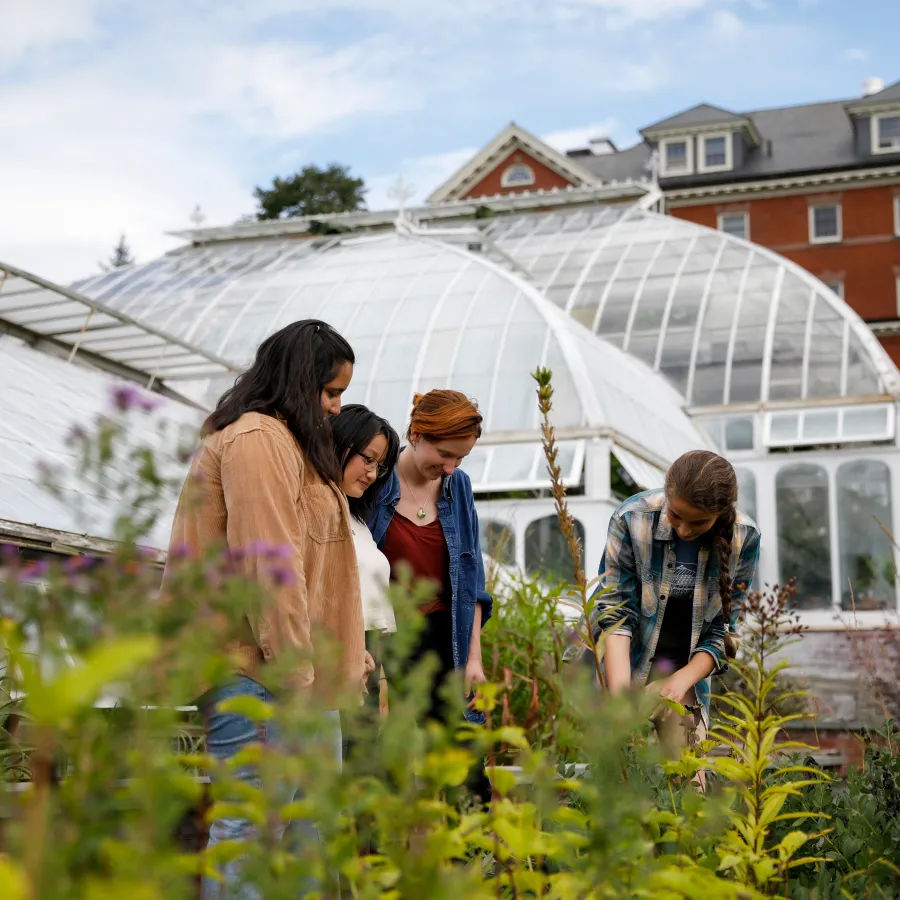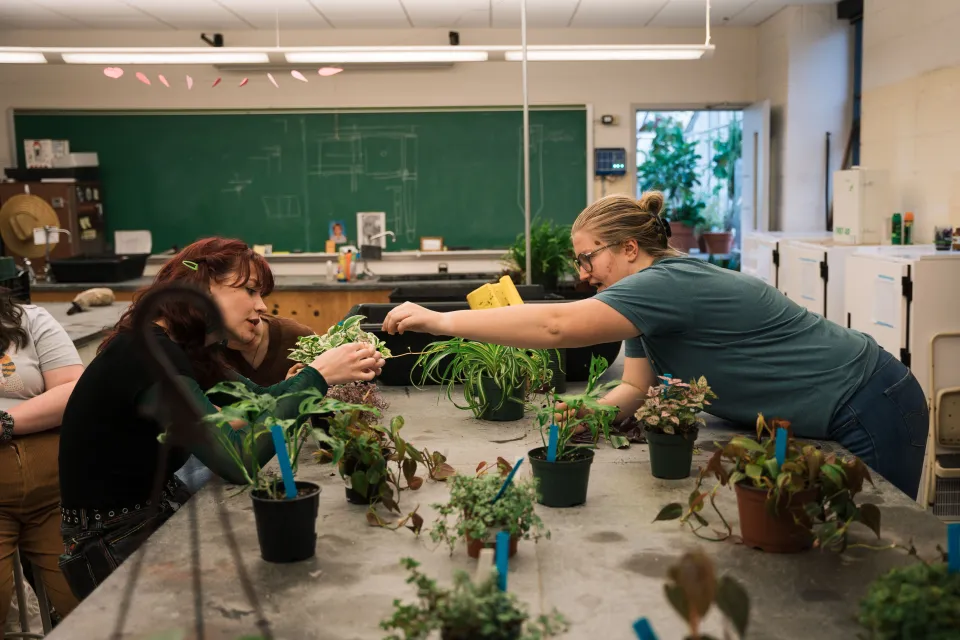Students Become the Teachers through the Botanic Garden Student Educators Program
Botanic Garden - Leaflet
By Manager of Education Sarah Loomis

Published April 4, 2024
Leaflet 2023
At the botanic garden, we teach the practice of close observation, believing that carefully looking at stems, leaves and flowers provides a pathway for understanding the whole plant and its role in the greater system. We take this attention to the individual and apply it beyond the plants we study to the students we work with, acknowledging that like the flora surrounding us, each student also offers something unique and essential to the community.
The Botanic Garden Student Educator (BoGSE) program began with this observation and in recognition that our educational work benefits from the contributions of a diversity of students. The program consists of a student cohort hired to amplify the educational efforts of the botanic garden by facilitating events, projects and collaborations aimed at connecting more people—students, staff and visitors—to our work. Now in its second year, the program is having a rich impact.
This spring semester BoGSEs hosted a Late Night at Lyman program in collaboration with the Office of Multicultural Affairs and a self-love Valentine’s event; developed and led student tours; conducted tea blending, plant propagation and botanical body-care workshops; and officially launched the student-managed Learning Garden, first creating a planting plan for the space and then hosting seed-starting and sign-making workshops in support of it. Under the leadership of our education intern, the group is also curating a summer pop-up exhibit aimed at connecting young children and their families with our collection.

In addition to planning and executing projects, BoGSEs help us to think deeply and critically around big questions related to the student experience. Together we tackle challenging questions and invite critique and reflection on what is working and what could be working better. As BoGSEs, they have been tasked with expanding outreach efforts of the botanic garden and part of that work is to apply a critical eye to our current efforts. These student voices help guide our co-curricular programming efforts and ensure that we are working to be as student-centered as possible.
The program is an example of what happens when Smith students are intentionally mentored and simultaneously given space to bring their whole selves to their work. They rarely disappoint. There is, of course, an invisible hand providing structure and vision, and also gauging just how much responsibility will allow students to soar without stretching them too thin as they learn how to operate in a professional space. In addition to guiding weekly team planning sessions, I meet with students individually to check in and provide direct support, ensuring that they have the tools they need to successfully accomplish their projects. Hiccups are expected. Miscalculated weekly obligations, mental health challenges and unexpected injuries, heartbreaks and family losses are reminders that we are human. Each situation provides an opportunity for self-reflection and continued personal and professional growth. Equally important is the way these challenges make space for the cohort to show up for one another—as one member of the team struggles, the others shift to support them.
This model has its vulnerabilities, as the work is so deeply influenced by interpersonal dynamics within the cohort. BoGSEs change annually, meaning the cohesive magic of one year may be challenging to build the next. But these potential issues are mitigated by the simple fact that our ultimate objective is not productivity—although there is plenty of that—but learning. And part of learning is recognizing that we do not work in silos, but in relationship to one another and, equally important, in relationship to the world around us.
As students dive deeply into their college experiences, programs like ours provide space for experimentation and application, which greatly enhances their academic studies. But the Botanic Garden of Smith College offers students something complementary and magnifying as well: the chance for connection both to one another and to the living things that surround us. In this way, our work is simple in approach but profound in impact. Below you can hear from four previous and current students as they reflect on the program. Some were part of its genesis, others were in its pilot year, and still others are current BoGSEs.
These collective voices demonstrate how the program is growing and shifting each year, as students continue to define what the BoGSE program is and what it can be. For my part, I’m excited to watch it evolve to tackle unique interests and trial new ideas. I have no doubt that these students, and those that come next, will continue to explore and demonstrate their own plant passion in unexpected and powerful ways, and the botanic garden will be all the better for it.
Student Reflections
McKenzie Swart AC ’21
“When you come and have an experience like I had here, you get a glimpse of your whole self.”
I came to Smith and for that whole first year, I was just angry. I didn’t want to be here. But then I started doing the botanic garden internship and then I pivoted to laying the foundation for the BoGSE program. When the pandemic hit I struggled for a while, but through it all [I was part of something here]. Maybe I’m that type of person who has to be a part of something bigger in order to feel like my work matters. And I was always that here. I was always part of something new—with John BerryHill and his conservation work, with the concentration research, with exploring the BoGSE program—those were new ideas. And I always appreciated that—to be asked to show up in a way that was just kind of different than I ever had been before.
Something that I learned here is that before coming to Smith, I didn’t really know the meaning of words like “community” and “engagement.” When you come from a place like I came from, you don’t have those things. So to come here and have someone say “Come and be a part of this” was really special and it significantly changed my life. And now I do that for others. My time here made me feel safe enough to reach out and invite people in. It became easy. It’s like learning a language and once you learn it, you don’t forget it.
Liliana Martinez
The botanic garden felt like a picture of life within an academic institution like Smith. As a first-year student from South Texas, I felt out of place in the new landscape and was surprised to find familiar plants in the botanic garden collection. I came to the realization that this natural life could connect a student body through a range of cultures and backgrounds. Plants served as a common ground, transcending borders and languages while honoring our distinct lived experiences. The botanic garden quickly became a favorite space of mine on campus and becoming a BoGSE was significant for my Smith experience as a whole. So much education is limited to the intellectual, but I found hands-on learning and a world of knowledge not limited to that within the greenhouses. I learned from fellow BoGSEs and our mentors around the garden. I learned about BIPOC contributions to horticulture, local farm worker organizing and food sovereignty within the Pioneer Valley. It felt like we BoGSEs contributed to a culture of growth and connection, starting with Smith and reaching into the greater community. I am deeply grateful for this experience, and continue to pursue growth and connection in my work and learning beyond Smith.
Jamila dePeiza-Kern ’22
During the summer before my senior year at Smith I heard about the Botanic Garden Student Educator Program and immediately knew I wanted to be involved. I was thrilled to be hired as the education intern and to work alongside Education Manager Sarah Loomis and witness the program’s development from infancy into a thriving part of the botanic garden’s landscape.
The BoGSE program influenced my career journey. I had never before tried my hand at education, but because of the program, I developed an interest in teaching and the courage to apply for a job as a youth educator with Speak for the Trees, Boston the summer after my graduation.
I worked at the botanic garden all four years I spent at Smith, in various capacities. This was my first foray into education. It felt daunting at first, but equally exciting. I firmly believe that education is not a one-way street—flowing from knowledgeable teachers to questing students. Instead, everyone’s views are valuable, and we all learn from one another. This belief was exemplified during my time working with the BoGSEs. One of my favorite parts of the program was how, during our weekly meetings, we would take turns introducing plants from the collection and sharing what we had discovered through our research. When planning events, we collaborated to come up with interesting ideas to enrich the visitor experience. It was all really informative as well as a lot of fun. I’m very grateful for the time we all spent together.
Meredith Jones ’24
Lyman is the place on campus where I feel most at home and part of the Smith community. As someone who grew up in Maine, feeling connected to the landscape around me is what makes me feel at home in new places. I was immediately drawn to the botanic garden when I was a first-year and I jumped at the opportunity to become more integrated into the Smith community and physical landscape through working as a BoGSE. I love working on a team of student educators who feel passionately about making the botanic garden a welcoming space for students to connect with each other and to plants. As an anthropology major with an interest in education, art and museum studies, I am able to marry a lot of my interests while working at the botanic garden, whether I am working to help set up an exhibit of student art in the Lyman Gallery or leading a propagation workshop for students.
I am extremely grateful to be a part of the botanic garden through the student educator program. The BoGSE program allows many avenues for me to be self-directed and develop invaluable professional experience with leadership, outreach and working on a team. The student educator program has given me the opportunity to work with botanic garden staff and think about future careers that I might want to pursue in horticulture and education. I love that I am able to gain professional experience in a field I am interested in pursuing while connecting to my Smith community.